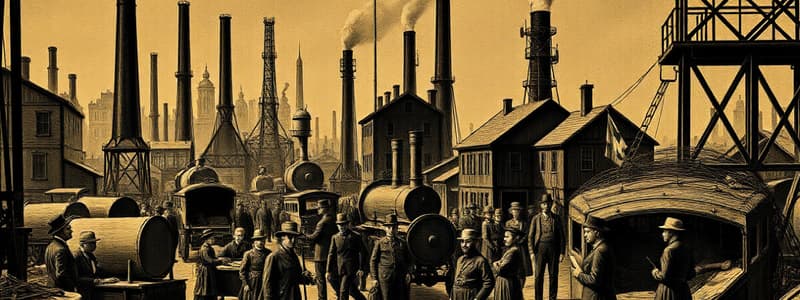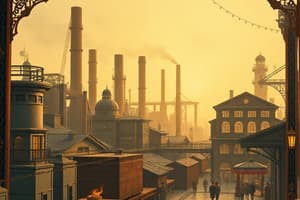Podcast
Questions and Answers
What primarily attracted immigrants to urban areas during the Gilded Age?
What primarily attracted immigrants to urban areas during the Gilded Age?
- Need for cheap labor (correct)
- Desire for education
- Pursuit of religious freedom
- Access to natural resources
What demographic change occurred in cities due to immigration during the Gilded Age?
What demographic change occurred in cities due to immigration during the Gilded Age?
- Higher birth rates among native citizens
- Increased diversity of ethnic groups (correct)
- Decreased population density
- Reduction of urban slums
What was a common challenge faced by new immigrants in urban areas?
What was a common challenge faced by new immigrants in urban areas?
- Abundance of resources
- Discrimination and poverty (correct)
- Room for cultural integration
- Access to high-paying jobs
What resulted from the rapid growth of cities during the Gilded Age?
What resulted from the rapid growth of cities during the Gilded Age?
How did the concentration of immigrants in urban areas affect social structures?
How did the concentration of immigrants in urban areas affect social structures?
What was a political consequence of the industrialization and immigration phenomena during the Gilded Age?
What was a political consequence of the industrialization and immigration phenomena during the Gilded Age?
Which of the following best describes the types of jobs that new immigrants typically held during the Gilded Age?
Which of the following best describes the types of jobs that new immigrants typically held during the Gilded Age?
What necessity arose as a consequence of population growth in urban areas during the Gilded Age?
What necessity arose as a consequence of population growth in urban areas during the Gilded Age?
Flashcards
Urbanization during the Gilded Age
Urbanization during the Gilded Age
Rapid growth of cities during the late 19th century due to industrialization and immigration.
Immigration during the Gilded Age
Immigration during the Gilded Age
Waves of people moving to a new country, particularly to the United States, seeking better economic opportunities during the industrial revolution.
The Gilded Age
The Gilded Age
A period in American history marked by rapid industrial growth and significant social changes, characterized by both progress and inequality.
Industrialization during the Gilded Age
Industrialization during the Gilded Age
Signup and view all the flashcards
Urban Challenges during the Gilded Age
Urban Challenges during the Gilded Age
Signup and view all the flashcards
Ethnic Enclaves during the Gilded Age
Ethnic Enclaves during the Gilded Age
Signup and view all the flashcards
Labor Movements during the Gilded Age
Labor Movements during the Gilded Age
Signup and view all the flashcards
Income Disparities during the Gilded Age
Income Disparities during the Gilded Age
Signup and view all the flashcards
Study Notes
The Gilded Age and Industrialization: Immigration and Urbanization
- The Gilded Age, a period of rapid industrialization in the late 19th century, greatly impacted immigration patterns and urban growth.
- Industrialization spurred a demand for cheap labor, attracting large-scale immigration seeking economic opportunities.
- This immigration influx significantly changed the demographics of cities, resulting in substantial urban populations and diverse ethnic groups.
- Factories' proliferation in urban areas provided employment for immigrants, further accelerating population growth.
- New immigrants faced significant social and economic challenges, including discrimination, poverty, and competition for limited resources.
- These hardships led to the development of urban slums, tenement housing, and ethnic enclaves, representing distinct communities with shared cultural backgrounds.
- Rapid urban growth strained existing infrastructure, including sanitation and transportation systems.
- Dense urban spaces led to overcrowding and related social problems.
- New urban governance and social services were needed to address these issues, often lagging behind population growth.
- Immigrants frequently worked hazardous, low-paying jobs in factories, mines, and other industries.
- The rapid industrialization created significant income and wealth disparities between wealthy industrialists and the working class.
- Many immigrants actively participated in labor movements to improve working conditions and wages.
- Immigrant concentration in urban areas fostered ethnic neighborhoods, preserving cultural traditions and languages.
- Diverse communities gave rise to new forms of communication and artistic expression.
- The growing city populations required new mass transit systems, such as streetcars and subways.
- Social reformers and organizations addressed urban poverty and discrimination.
- The intersection of industrialization, immigration, and urbanization significantly influenced the development of labor laws, social welfare programs, and political machines managing urban affairs.
- New social philosophies, like Social Darwinism, attempted to explain social inequalities, sometimes justifying discriminatory practices against immigrants and marginalized groups.
- New social institutions and organizations, like settlement houses, emerged to aid immigrants and address urban challenges.
- Rapid urbanization had negative environmental consequences, including pollution and the loss of open spaces.
Studying That Suits You
Use AI to generate personalized quizzes and flashcards to suit your learning preferences.
Description
This quiz explores the impacts of the Gilded Age, a transformative period characterized by rapid industrialization and significant immigration. Delve into how these changes influenced urban growth, demographics, and the social challenges faced by immigrants in cities. Test your understanding of the complex interplay between industry and society during this pivotal era.




